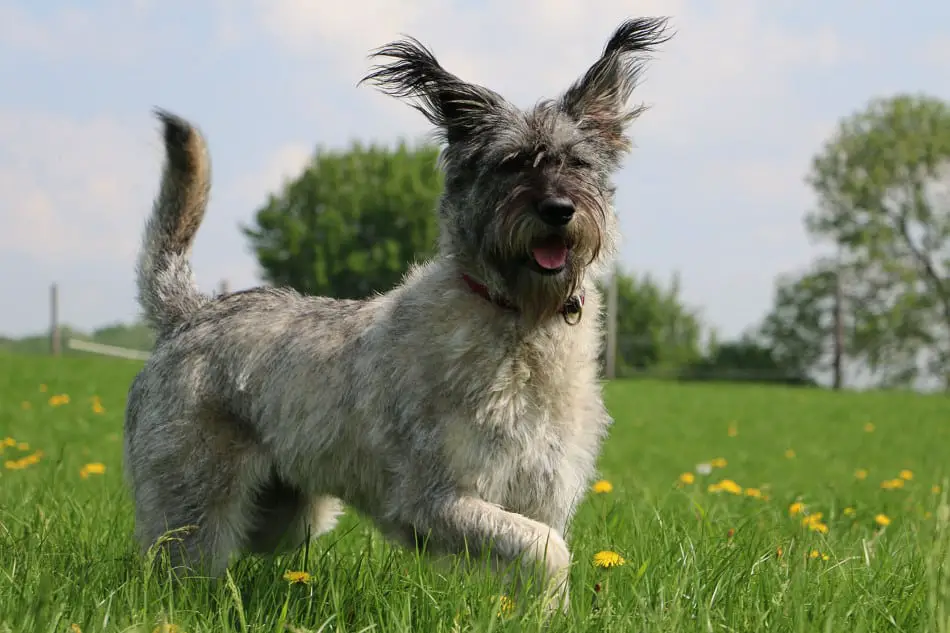Human ears are complicated and delicate enough, but what about our furry friends? Since a Schnauzer’s sense of hearing is so sensitive and well-developed, it’s natural that we would want to protect one of her most reliable senses. Plucking hair from the inside of a Schnauzer’s ear sounds delicate, and possibly even painful and risky. I wanted to know the facts, so I checked with several groomers and did some research. Here’s what I found.
Should I pluck my Schnauzer’s ears? It depends. If you check your Schnauzer’s ears regularly and there is no history of chronic infections, there is no medical reason to pluck them. However, Schnauzers do grow hair inside their ear canal and it is possible that bacteria can grow and cause infections. You can include plucking in a normal grooming routine, either by learning to do it yourself or asking your groomer to do it.
While it may seem like an odd thing to even wonder (let alone consider actually doing) plucking the hair from inside your Schnauzer’s ears is something you will at least want to know about.
Even if you don’t do it yourself and choose to defer to a professional groomer instead, it’s good to understand why your Schnauzer’s ears may (or may not) need to be plucked.
Is Ear Plucking Controversial?
The truth is that this is a somewhat controversial subject since groomers report seeing just as many ear infections in plucked ears as in ears that are not plucked regularly.
Controversy aside, it’s good to develop a habit of regularly inspecting your Schnauzer’s ears for growths, or other signs of problems such as infections, so before we cover facts about ear plucking, let’s talk about why you should consistently inspect your Schnauzer’s ears and how to recognize the signs of an ear infection.
Regularly Inspect the Ears for Hair, Inflammation, or Signs of Infection
Schnauzer’s ears are similar to caves with plenty of clefts and nooks where tiny microorganisms can flourish. The hair in the inner ear adds another complication because they can hold moisture and prevent evaporation. Unfortunately, dark and moist areas create excellent breeding conditions for bacteria.
Lots of hair in the ear can also block the airway and trap dirt, wax, and other build-up.
Simple Ways To Inspect Your Schnauzer’s Ear
Checking your Schnauzer’s ears regularly is one of the best ways to monitor ear health. It also helps you reduce the risk of your Schnauzer developing a more severe condition, such as an infected or inflamed ear.
- Stay alert to any signs of discomfort or pawing at ears
- Lift your Schnauzer’s ear, gently move any hair, and look inside for any redness or inflammation
- Smell your Schnauzer’s ear for any foul odor or even a “corn chip” smell that can signal an infection

Situations That Make Infections More Likely
In some instances, it’s difficult to determine the leading cause of infected or sore ears, but some conditions make it more likely your dog may develop ear problems.
- Swimming Regularly
- Having Floppy Ears
- Having Been Recently Diagnosed with an Allergy
There might be instances where your Schnauzer develops an ear infection for reasons beyond your control, showing minimal symptoms beforehand. This is the main reason why routinely checking her ears, and perhaps including regular ear cleaning and plucking, to your routine is beneficial.
Chronic ear infections or untreated ear infections in dogs may lead to conditions such as aural hematomas or even some neurological complications. Therefore, in breeds such as Schnauzers, which are prone to ear infections, keeping their ears clean is critical.
Signs of Ear Infections
When it comes to Schnauzers, ear cleaning can be somewhat more involved than other breeds because they grow excessive inner ear hair. That, plus the floppy or uncropped ears, creates the perfect condition for the yeast growth.
Because of these conditions specific to Schnauzers, inspecting ears weekly is a good idea, and then either choosing to clean and pluck them yourself or enlisting your groomer’s help.
Overgrowth of bacteria and yeast can cause otitis, which is another name for an infection or inflammation of the ear. If not early diagnosed and properly treated, ear infections can cause your Schnauzer pain, balance issues, and sometimes hearing loss.
It’s not difficult to tell when a Schnauzer is having some ear problems. The symptoms and behaviors will be too difficult to ignore, and cleaning or plucking his ear area will not help and might even make matters worse.

Here are common signs of an ear infection:
- Bleeding or redness in the ears
- Pawing at the ears
- Shaking the head excessively
- Tilting the head constantly to one side
- Yelping or whimpering in pain
- Scratching the ears continuously
- Rubbing ears in the grass or across the carpet
- Becoming irritable because of the pain
- Discharge of earwax
- Bad odor from ear area
If your Schnauzer shows any of the behaviors or symptoms outlined above, you should consider visiting a veterinarian to get professional advice before the condition gets worse.
Understanding Ear Plucking
If your Schnauzer’s ears are currently in good shape with no infections or problems, it’s time consider getting into a routine of inspecting and possibly plucking them, or at least talking with your groomer about plucking or gently shaving excess hair at each session.
What Exactly is Ear Plucking?
Ear plucking refers to the practice of utilizing hemostats, fingers, or any other tool to remove an excessive amount of hair from your Schnauzer’s ear canal.
As I’ve mentioned, droopy eared and hairy breeds such as Schnauzers are prone to accumulation of hair in the ear canals, which can trap moisture in his skin folds. That can prevent airflow, leading to escalated growth of fungi or bacteria and eventually cause infection and irritation.
If your Schnauzer’s ears are cropped (trimmed as a puppy), they may not be as prone to an overgrowth of hair. Either way, keeping her ears clear and clean is a best practice.
Removing the hair from a Schnauzer’s ear little by little and cleaning the ears properly after that can assist in preventing the accumulation of dirt in the ear canal and keep her ears healthier. You should not remove the hair in large chunks because it can further irritate the sensitive skin of the ear canal.
How Often Should I Pluck My Schnauzer’s Ears
How often you should pluck your Schnauzer’s ears depends on how fast she grows hair. In addition, older canines often tend to grow more ear hair than younger pups.
Some may benefit from ear plucking every couple of weeks, while others can go several months between tweezing. Your Schnauzer’s groomer may have some recommendations, but inspecting your Schnauzer’s ears yourself will give you the first-hand observation you need.
At the very least, it can be a conversation between you and your Schnauzer’s groomer every 4-6 weeks at grooming appointments.
You might also want to consult with your veterinarian at each annual check-up.
How To Pluck Your Schnauzer’s Ears
Plucking is often done when a Schnauzer is professionally groomed, although as I mentioned above, there are conflicting opinions among groomers about whether plucking is necessary.
You can take your Schnauzer to a professional groomer to pluck the ears for you, but if you feel comfortable doing it at home, you can request your groomer or vet to show you the best way to do it.
If you decide to learn how to pluck your Schnauzer’s ears, here are some options.
Supplies You Will Need
The supplies needed for plucking your Schnauzer’s ears are minimal. In addition to your own fingers and possibly another person to help keep your canine friend still, here is what you will need:
| Ear Powder | Ear powder will make the hair inside your Schnauzer easy to grip when plucking. You don’t have to use a lot of it, and you should be careful not to get any powder in your Schnauzer’s eyes or allow her to sniff it in when applying. The powder can cause irritations and damage to eyes and also irritate lungs. |
| Hemostats | This tool is optional because you can use your fingers to remove excess hair from his ears, but it can make clenching the more hard-to-reach hairs a bit easier. However, you should avoid utilizing human tweezers because they usually come with sharp edges that can scratch your Schnauzer’s ear, or lead to serious injuries if he moves or shakes his head when you are plucking. |
Ear Plucking Steps

- Apply some powder on your fingers and tightly grip small amounts of fur around the opening of the ear canal of your schnauzer.
- Apply some more powder or utilize a hair removal device if you cannot get a firm grip on the hair.
- Pluck the hair in a gentle and quick motion. You should avoid a tough jerk or a hard, steady pull on the hair. The hair should come out easily.
- Pluck enough fur to open up the ear canal of your dog. There’s no need to over-pluck.
- After plucking, you should clean the ear and wash out any powder residue.
When NOT to Pluck or Clean Your Schnauzer’s Ears
If your Schnauzer is uncomfortable and seems to be having a problem with one or both of his ears, please exercise caution.
If you notice any of the signs below, do not clean or pluck his ears. Don’t put anything in his ears….even medication….until your veterinarian can evaluate the situation. As with human medical doctors checking human ears, a veterinarian is the only one who should be taking a look deep into your Schnauzer’s ears.

Do not pluck or clean your Schnauzer’s ears if:
- There is any discharge from the ear
- There is a bad odor
- The ear flap is red, inflamed, and warmer than usual
- The ear canal is “stenotic” or much more narrow than usual
- Your Schnauzer tilts his head to one side
- Your Schnauzer exhibits “ataxia” which is walking like he is drunk
- Your Schnauzer is walking in circles
- Your Schnauzer favors or protects one ear
- Your Schnauzer cowers, barks, yelps, or even tries to bite when you are near his ear
Keeping your Schnauzer’s ears clean and healthy is a standard part of grooming. It’s also important for her long-term health and comfort.
Whether you decide to pluck her ears or not, understanding the pros and cons will ensure that you have informed options.
Ultimately, the most common-sense approach is to inspect your Schnauzer’s ears regularly and get help when necessary.
And finally, from one pet parent to another, discover my all-time favorite resources designed to cover your every Schnauzer need. I’ve done the legwork for you so you can spend more time with the people and fur friends in your life.
A portion of all profit earned on this site is donated to Pet Partners
whose mission is to improve human health and
well-being through the human-animal bond.
They train and register pets to become therapy animals,
and have local chapters in many states.

